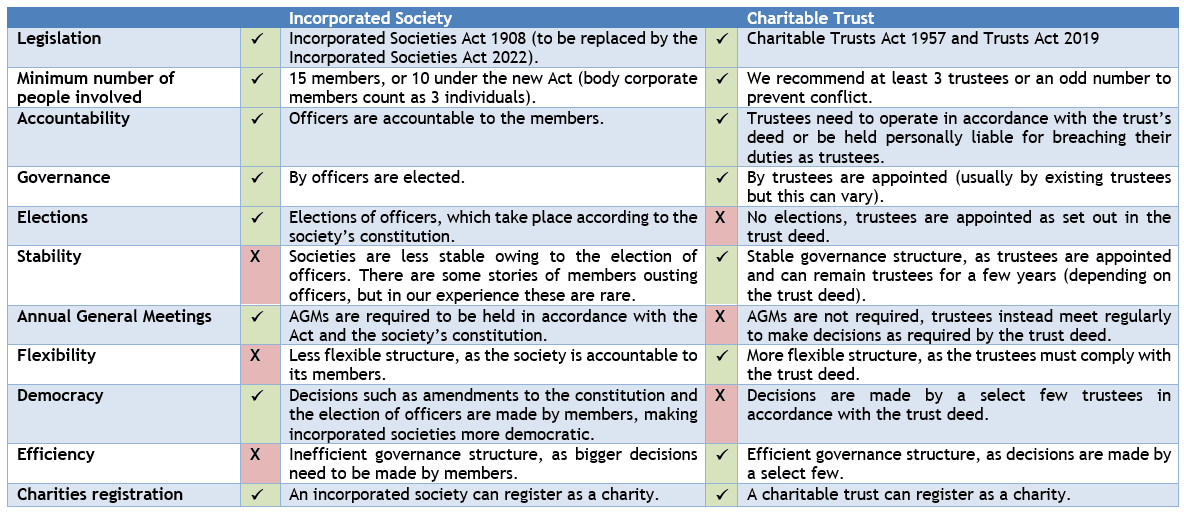Introduction
The Incorporated Societies Act 2022 (the “new Act”) recently received Royal Assent, resulting in significant changes for the 24,000 incorporated societies in New Zealand. The new Act replaces the Incorporated Societies Act 1908, which has been long overdue for an upgrade. We have discussed ten key changes for incorporated societies to be aware of in our article here.
In this article we will do a deep dive into one of the many changes in the new Act, namely the conflict of interest disclosure procedure. This will be important for incorporated societies to get right to ensure those involved are not conflicted, or if they are that the conflicts are disclosed.
When an officer has interest in a matter
The new Act requires an officer to disclose when they are interested in “a matter”. A matter is defined in section 62(4) of the new Act as meaning a society’s performance of its activities or exercise of its powers, or a transaction made or entered into, or proposed to be entered into, by the society.
Under section 62 of the new Act, an officer is interested in a matter if they or one of their relatives may obtain financial benefit from the matter, or they or one of their relatives may have a financial interest in a person to whom the matter relates, or they are interested in the matter because the society’s constitution says so. However, an officer is not interested in a matter:
- simply because they receive indemnity, insurance cover, remuneration, or other benefits authorised under the new Act; or
- if the officer’s interest is the same or substantially the same as the benefit or interest of all or most other members of the society due to their membership; or
- if the officer’s interest is so remote or insignificant that it cannot reasonably be regarded as likely to influence the officer in carrying out their responsibilities under the Act or the society’s constitution; or
- the officer’s interest is of a kind that is specified in the society’s constitution for the purposes of section 62(2)(d).
The starting point then is to work out if there is a conflict using those criteria. Not everything is a conflict.
Duty of disclosure
If an officer is interested in a matter relating to the society, under section 63 of the new Act they must disclose the details of the nature and extent of the interest (where possible including monetary value of the interest) to the committee and record it on the interests register (discussed below). This disclosure must be made as soon as practicable after the officer becomes aware of their interest in the matter.
The interests register
The interests register is a register of all of the disclosures made by officers under section 63. It is kept and maintained by the committee, and may be inspected by an officer at any reasonable time as set out in section 73 of the new Act.
Consequences of an officer’s interest
As a result of their interest in the matter, the officer cannot vote or take part in a decision of the committee relating to the matter or sign any document relating to the entry into a transaction or the initiation of the matter, as set out in section 64(1)(a)-(b) of the new Act. However, the officer can take part in discussion relating to the matter and be present when the committee are making a decision (unless the committee decides otherwise). All of the officers who are not interested in the matter can consent to the interested officer doing the acts set out in section 64(1)(a)-(b), thereby allowing the interested officer to do any of these acts. Despite this, if half or more of the officers are interested in the matter and therefore cannot vote, the committee must call a special general meeting to determine the matter under section 64(3).
Notice to members in certain circumstances
If an officer does not disclose their interest in a matter under section 63 or is interested in a matter but still takes part in a vote, decision making or signing of documents in relation to the matter in contravention of section 64, then the committee must notify the members of the society in accordance with section 65(1) of the new Act. This notice would be of the failure to comply with section 63 or 64 and should list any transactions affected, and be sent out as soon as practicable after the committee becomes aware of the failure.
Where an officer is interested in a transaction, section 68(1) of the new Act allows a society to avoid the transaction up to three months after the society has notified its members under section 65(1). It’s not as easy as that, though – there are further limitations set out below.
Permissible amendments to the conflict of interest disclosure procedure
There is some flexibility here. The new Act gives a society the ability to negate, limit or modify the above (except for section 62, which explains when an officer has an interest in a matter). Under section 67 of the new Act, a society’s constitution may negate, limit or modify any provisions of sections 63, 64, 65(1) and 73 as long as the changes still satisfy the conditions prescribed by the regulations (if any).
The society’s constitution may also negate or limit the society’s ability to avoid a transaction under section 68(1) as long as the changes still satisfy the conditions prescribed by the regulations (if any). This means, for example, a society could require two thirds of officers to be interested in the matter before a special general meeting is called to determine the matter rather than half. We have prepared detailed notes on what your constitution must contain under the new Act which are available here, and can help you to consider your options in relation to your conflict of interest disclosure procedure.
What cannot be changed
There are some parts of the new Act that cannot be altered by the society’s constitution:
- Section 65(2)-(3), which explains that any failure to comply with section 63 or 64 does not affect the validity of the new act, but this does not limit a person’s right to apply for judicial review.
- Section 66, which says that regulations may require every member of the society to be notified or for notification to be made to the members as a group.
- Section 68(2)-(4), which says that a transaction cannot be avoided under section 68(1) (discussed earlier) where the society received fair value under it. Fair value is defined in section 69 and the onus of proving fair value is set out in section 70. Additionally, a transaction can only be avoided on the ground of the officer’s interest, and a constitution cannot allow a transaction to be avoided in any circumstances other than those set out in the new Act.
- Section 71, which explains that if a third party has acquired property from a person other than the society for valuable consideration and without knowledge of the circumstances of the transaction under which the other person initially acquired the property from the society, the avoidance of a transaction will not affect the third party’s title or interest to or in the property.
- Section 72, which reiterates that the conflict of interest procedure does not apply in relation to salary, wages or other payments paid to officers in accordance with section 24(1)(h), or an indemnity given or insurance provided in accordance with subpart 6.
Summary
With the new Act comes a lot of changes to the requirements for an incorporated society’s constitution. We have helped many incorporated societies over the years and would be happy to discuss your situation with you, especially when it comes to amending your society’s constitution so it meets the requirements set out in the new Act. You can contact us any time by email or phone.
We have a lot more resources at this page dedicated to the Incorporated Societies Act 2022.
This article is not a substitute for legal advice and you should consult your lawyer about your specific situation. Please feel free to contact us at Parry Field Lawyers.


